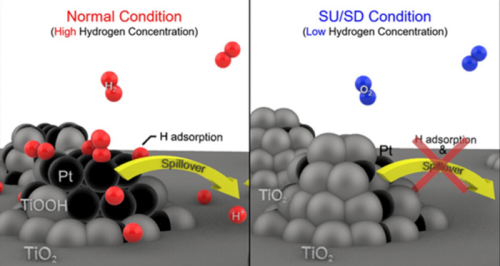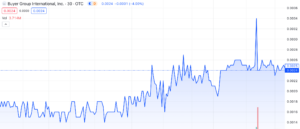Precious Metals
Researchers develop selective catalyst that curbs corrosion in automotive fuel cells
A research team led by Professor Yong-Tae Kim and PhD candidate Sang-Hoon You at Pohang University Of Science & Technology (POSTECH) has developed…

A research team led by Professor Yong-Tae Kim and PhD candidate Sang-Hoon You at Pohang University Of Science & Technology (POSTECH) has developed a selective catalyst that curbs corrosion in fuel cells used for hydrogen-powered automobiles.
By tailoring the hydrogen oxidation reaction to match the concentration of hydrogen in the fuel cell, the team was able to hinder the corrosion of the fuel cells. The research was published in ACS Energy Letters.
Fuel cells are susceptible to numerous factors that deteriorate their durability. One of them is degradation, especially in the cathode catalyst, which is routinely exposed to start-up and shut-down events in automobiles. During normal vehicle operation, fuel cells are supplied with a consistent supply of hydrogen with high concentration, but the concentration of hydrogen temporarily declines when the car is turned off or started. Consequently, when external air mixes with hydrogen within the fuel cells, an unintended oxygen reduction reaction in the anode is triggered, leading to sudden potential jumps and carbon corrosion in the cathode.
Left. In the picture, hydrogen spillover is depicted, wherein TiO2 undergoes transformation into TiOOH under high hydrogen concentration conditions, which promotes hydrogen mobility on the surface and consequently produces conductivity. Right. The picture shows that under relatively low hydrogen concentration conditions, the strong interaction between Pt and TiO2 leads to the covering of Pt by TiO2. Credit: POSTECH
The research team engineered a catalyst (Pt/TiO2), consisting of platinum (Pt) deposited onto titanium dioxide (TiO2), that efficiently halts corrosion in fuel cells employed in hydrogen-powered automobiles. The performance of this electrocatalyst comes from the robust interaction between titanium dioxide and platinum, and the ability of hydrogen spillover to modify the surface conductivity of the material in response to the hydrogen concentration in its vicinity.
When a vehicle suddenly stops or starts, the concentration of hydrogen within the fuel decreases correspondingly. As a consequence of this reduction in hydrogen concentration, there is an expansion of titanium dioxide onto platinum, which results in platinum being buried beneath the catalyst’s surface. This burying of the platinum, caused by expansion of titanium dioxide, ultimately transforms the catalyst into an insulator due to the low conductivity of titanium dioxide.
This insulating effect hinders the catalyst’s ability to conduct electricity, thus preventing an unwanted reduction of oxygen that could cause sudden potential jumps in the cathode.
Conversely, during standard operation, the concentration of hydrogen remains high. Under such high hydrogen concentration conditions, the highly conductive platinum is exposed on the catalyst’s surface, and titanium dioxide reduction occurs, which promotes hydrogen mobility on the catalyst’s surface. This phenomenon, termed hydrogen spillover, enhances current flow and increases hydrogen oxidation reaction.
The research team also performed a simulation test to compare the newly developed catalyst and conventional catalysts. The test results demonstrated that fuel cells using Pt/TiO2 catalyst exhibited three-times-higher durability, relative to traditional fuel cells.
This study was conducted with the support from the Future Material Discovery Program, the Hydrogen Energy Innovative Technology Development Project, and the Mid-career Researcher Program of the National Research Foundation of Korea.
Resources
-
Sang-Hoon You, Sang-Mun Jung, Kyu-Su Kim, Jinhyeon Lee, Jinkyu Park, Ho Yeon Jang, Sangyong Shin, Hyunjoo Lee, Seoin Back, Jinwoo Lee, and Yong-Tae Kim (2023) “Enhanced Durability of Automotive Fuel Cells via Selectivity Implementation by Hydrogen Spillover on the Electrocatalyst Surface” ACS Energy Letters 8 (5), 2201-2213 doi: 10.1021/acsenergylett.2c02656

Canadian Silver Co. Will See Big Changes in 2024
Source: Michael Ballanger 12/22/2023
Michael Ballanger of GGM Advisory Inc. takes a look at the current state of the market and shares on stock…
EGR options out Urban Berry project in Quebec to Harvest Gold – Richard Mills
2023.12.23
EGR Exploration Ltd. (TSXV: EGR) has moved from owner to shareholder at its Urban Berry project in Quebec, this week announcing it is optioning…
Crypto, Crude, & Crap Stocks Rally As Yield Curve Steepens, Rate-Cut Hopes Soar
Crypto, Crude, & Crap Stocks Rally As Yield Curve Steepens, Rate-Cut Hopes Soar
A weird week of macro data – strong jobless claims but…


















